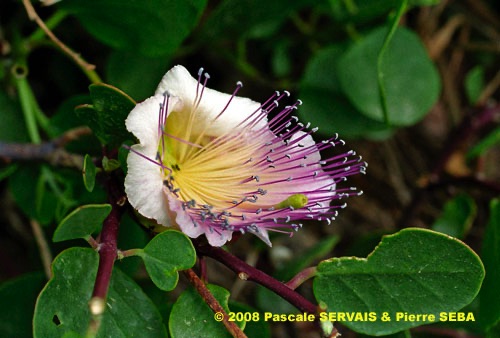
Capparis spinosa L.
Fam. : Capparaceae
© Pascale SERVAIS & Pierre SEBA, 2018. Tilo Botanica: Flore de Tilos et du Dodécanèse / Flora of Tilos and of the Dodecanese
English translation by Brenda Bradbury, Howard Bradbury and Stéphane Léonard
Arbrisseau hermaphrodite, rampant, à tiges glabres et enchevêtrées, à ramifications lâches et épineuses.
Feuilles alternes, simples, orbiculaires, à base cordée, à stipules transformées en courtes épines tombant très tôt, glabres, lisses, de 4 à 6 cm de diamètre, entières, coriaces, sans pointe épineuse, à pétiole court.
Fleurs à symétrie radiaire, isolées à l’aisselle des feuilles, blanches ou roses, de 4 à 6 cm de diamètre, à long pédoncule. 4 pétales libres enroulés et 4 sépales vert pourpré. Nombreuses étamines roses ou pourpres en faisceau, jusqu’à 2 fois plus longues que les pétales. Les jeunes boutons floraux se cueillent et se conservent dans la saumure pour être utilisés dans les salades. Ovaire supère.
Fruits, baies coriaces et charnues, vertes ou jaunâtres puis rougeâtres à maturité, de 50 mm de long au plus, s’ouvrant en 2, à chair rose et à nombreuses graines.
___________________________
Shrub hermaphrodite, trailing. Stems glabrous and tangled up, with loose and spiny ramifications.
Leaves alternate, simple, orbicular, with a cordate base, with stipules transformed into short thorns falling very early, glabrous, smooth, from 4 to 6 cm in diameter, entire, tough, without a spiny point, with a short petiole.
Flowers radially symmetrical, solitary at the axil of the leaves, white or pink, from 4 to 6 cm in diameter, with a long peduncle. 4 coiled free petals and 4 purple green sepals. Many pink or purple stamens in bundle, up to 2 times longer than the petals. The young floral buds are gathered and are preserved in brine to be used in salads. Ovary superior.
Fruits, tough and fleshy berries, green or yellowish then reddish at maturity, of 50 mm long at most, opening in 2 parts, with pink flesh and many seeds.
Descripteurs / Identifying features
1
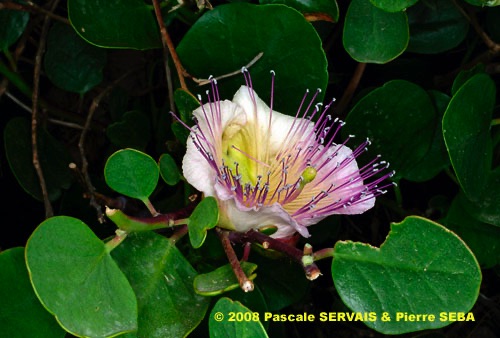
2
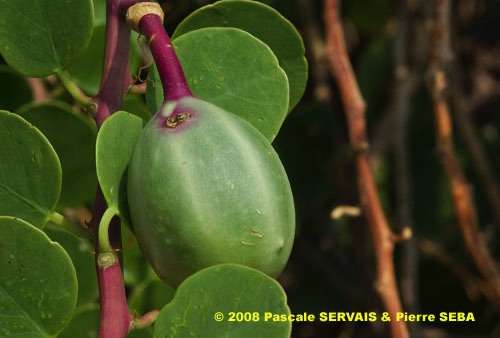
3
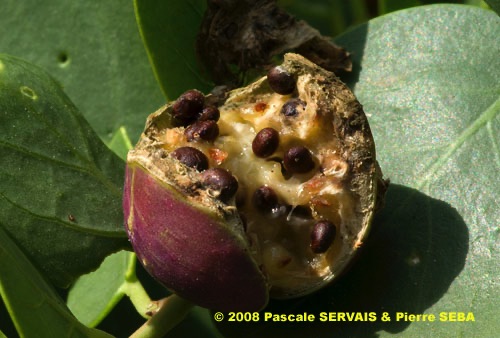
4

5
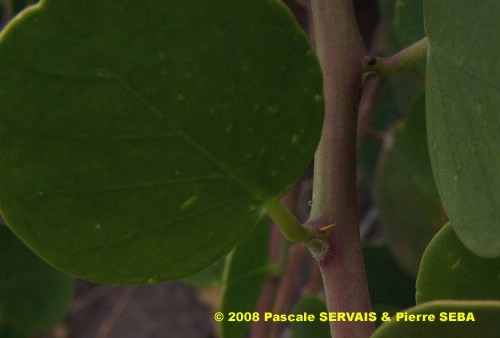
6
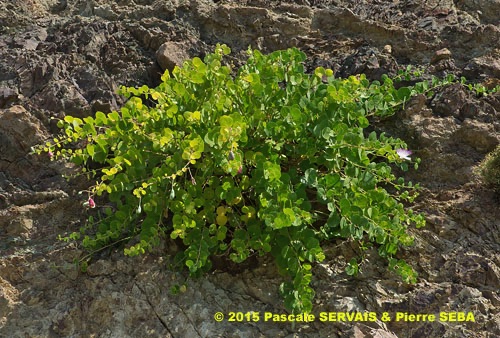
7
Étymologie / Etymology :
Capparis : emprunt du grec ancien κάππαρις, -εως (nom) = le câprier,
la câpre, nom donné à la plante par Théophraste, philosophe
péripatéticien, disciple d’Aristote, botaniste et naturaliste, mort
vers 288 av. J.-C.
Spinosa : emprunt du latin spinosus, -a, -um (adj.) [ < spina, -ae
(nom) = l’épine ] = pointu, épineux, couvert d’épines, en référence aux
parties épineuses de la plante.
Capparis : borrowed from Classical Greek κάππαρις, -εως (noun)
= caper, name given to the plant by Theophrastus, peripatetic
philosopher, disciple of Aristotle, botanist and naturalist, died
towards 288 BC.
Spinosa : borrowed from Latin spinosus, -a, -um (adj) [ < spina, -ae
(noun) = spine ] = sharp, spiny, covered in thorns, referring to the
spiny parts of the plant.
Synonymes / Synonyms :
Capparis deserti (Zohary) Tackh. & Boulos
Capparis leucophylla DC.
Capparis murrayana J.Graham
Capparis nepaulensis DC.
Capparis spinosa subsp. spinosa
Capparis spinosa var. deserti Zohary
Capparis spinosa var. spinosa
Noms vernaculaires / Common names :
Noms français / French names :
Câprier — Câprier épineux.
Noms grecs / Greek names :
Κάππαρη — Κάππαρη η ακανθώδης — Κάππαρη η ακανθωτή —
Καππάρι ακανθώδης — Κάππαρις — Κάππαρις η αγκαθωτή.
Noms anglais / English names :
Caper — Caper plant — Caper tree — Caperbush —
Common caper bush — Fabagelle — Mediterranean caperbush —
Spiny caperbush — Tapana — Tapera.
Noms allemands / German names :
Dorniger Kapernstrauch — Echter Kapernstrauch — Kaper —
Kapernstrauch.
Noms espagnols / Spanish names :
Alcaparra — Alcaparrera — Alcaparro — Tápana — Taparera —
Tapenera.
Noms italiens / Italian names :
Cappero — Cappero comune.
Habitat :
Lieux pierreux - Lieux incultes - Chemins.
Stony places - Waste ground - Waysides.
Île / Island :
Tilos.
Hauteur / Height range :
De 30 cm à 1 m.
From 30 cm to 1 m.
Floraison / Flowering time :
De mai à septembre.
From May to September.
Groupe / Classification :
Dicotylédones.
Dicotyledons.
Pérennité / Lifespan :
Vivace.
Perennial.
Description :
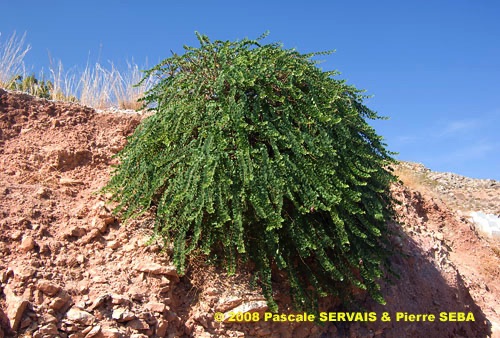
8
Clés dichotomiques et descripteurs distinctifs des 2 espèces / Dichotomous keys and distinctive identifying features of the 2 species
Photo 1 :
Localisation / Location : Tilos, Livadia, Village
Date : 08/05/2007
GPS : Lat. 36,41848° N / Long. 27,38636° E / Alt. 7 m
Type : Kodak Gold 200 ASA
Photo 2 :
Localisation / Location : Tilos, Livadia, Village
Date : 08/05/2007
GPS : Lat. 36,41848° N / Long. 27,38636° E / Alt. 7 m
Type : Kodak Gold 200 ASA
Photo 3 :
Localisation / Location : Tilos, Livadia, Village
Date : 23/09/2008
GPS : Lat. 36,41848° N / Long. 27,38636° E / Alt. 7 m
Type : Photographie numérique / Digital Photograph (10 mégapixels)
Photo 4 :
Localisation / Location : Tilos, Megalochorio, Erystos
Date : 26/09/2008
GPS : —
Type : Photographie numérique / Digital Photograph (10 mégapixels)
Photo 5 :
Localisation / Location : Tilos, Livadia, Village
Date : 20/09/2008
GPS : Lat. 36,41848° N / Long. 27,38636° E / Alt. 7 m
Type : Photographie numérique / Digital Photograph (10 mégapixels)
Photo 6 :
Localisation / Location : Tilos, Livadia, Village
Date : 20/09/2008
GPS : Lat. 36,41848° N / Long. 27,38636° E / Alt. 7 m
Type : Photographie numérique / Digital Photograph (10 mégapixels)
Photo 7 :
Localisation / Location : Tilos, Megalochorio, Aghios Pandeleimonas
Date : 18/09/2015
GPS : Lat. 36,44839° N / Long. 27,30422° E / Alt. 257 m
Type : Photographie numérique / Digital Photograph (24 mégapixels)
Photo 8 :
Localisation / Location : Tilos, Livadia, Village
Date : 27/09/2008
GPS : Lat. 36,41818° N / Long. 27,38615° E / Alt. 7 m
Type : Photographie numérique / Digital Photograph (10 mégapixels)

Google Maps
Google Maps
Google Maps
Google Maps
Google Maps
Google Maps
Google Maps